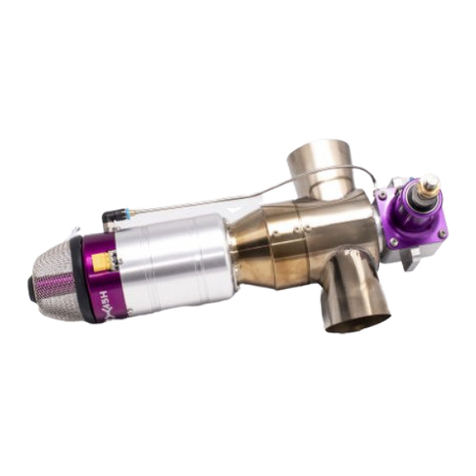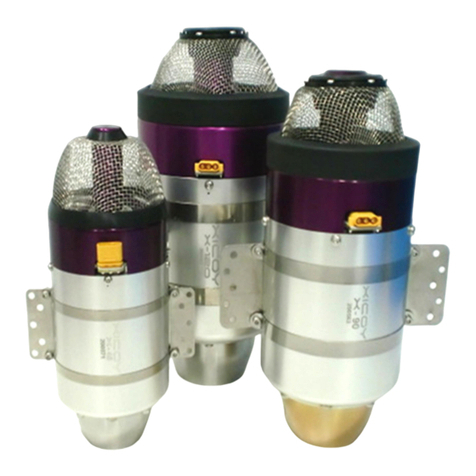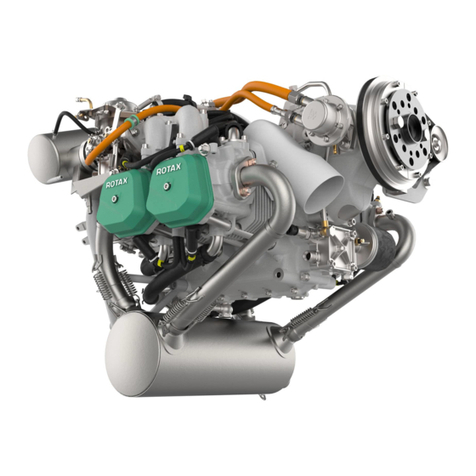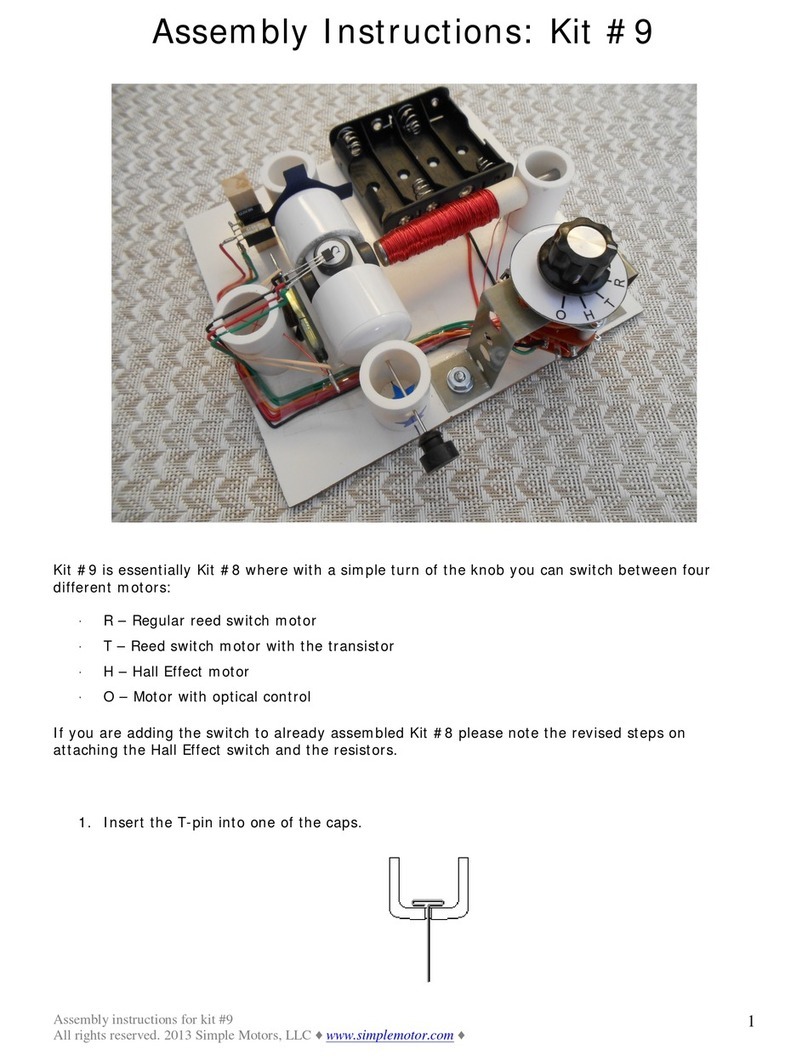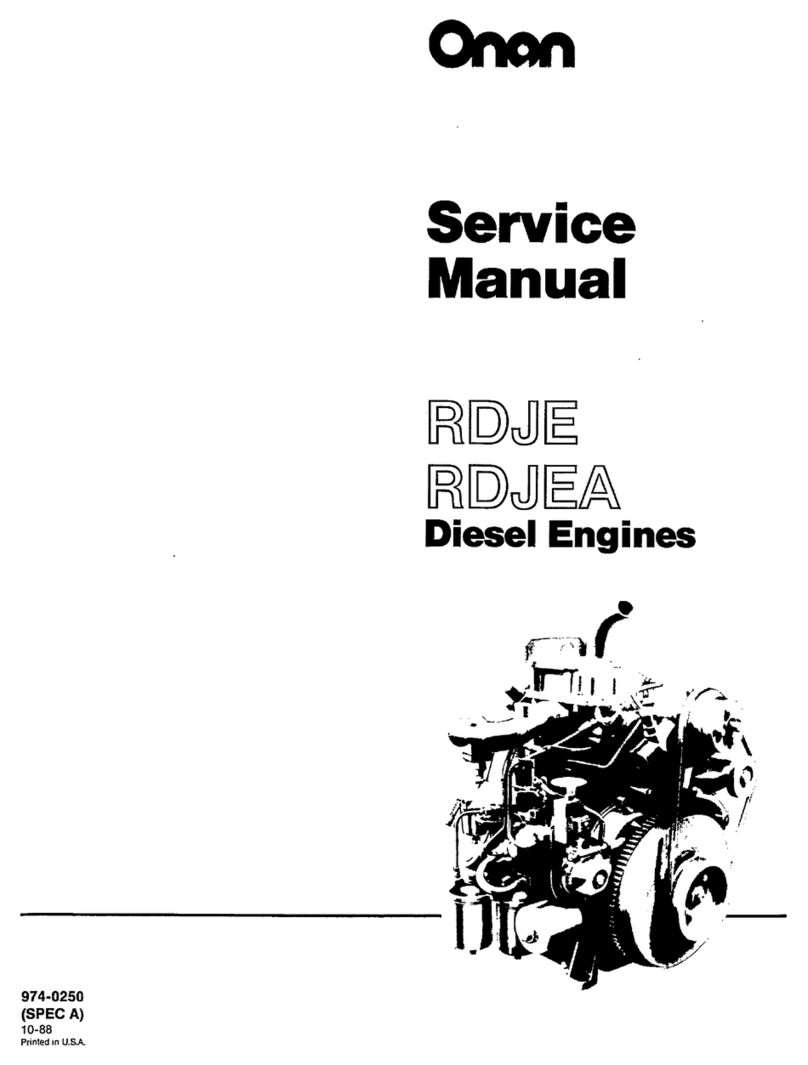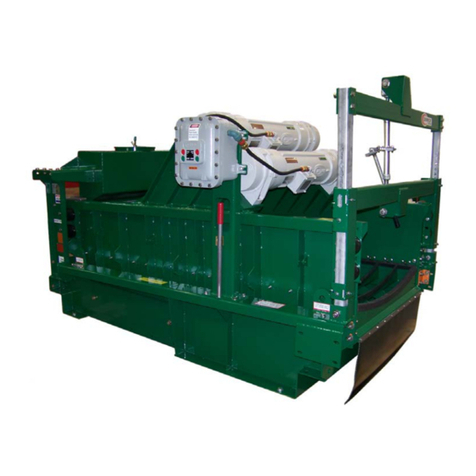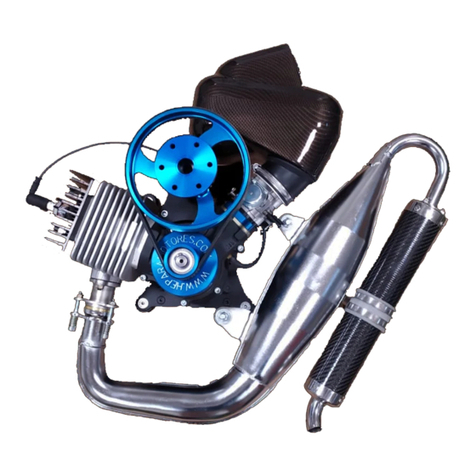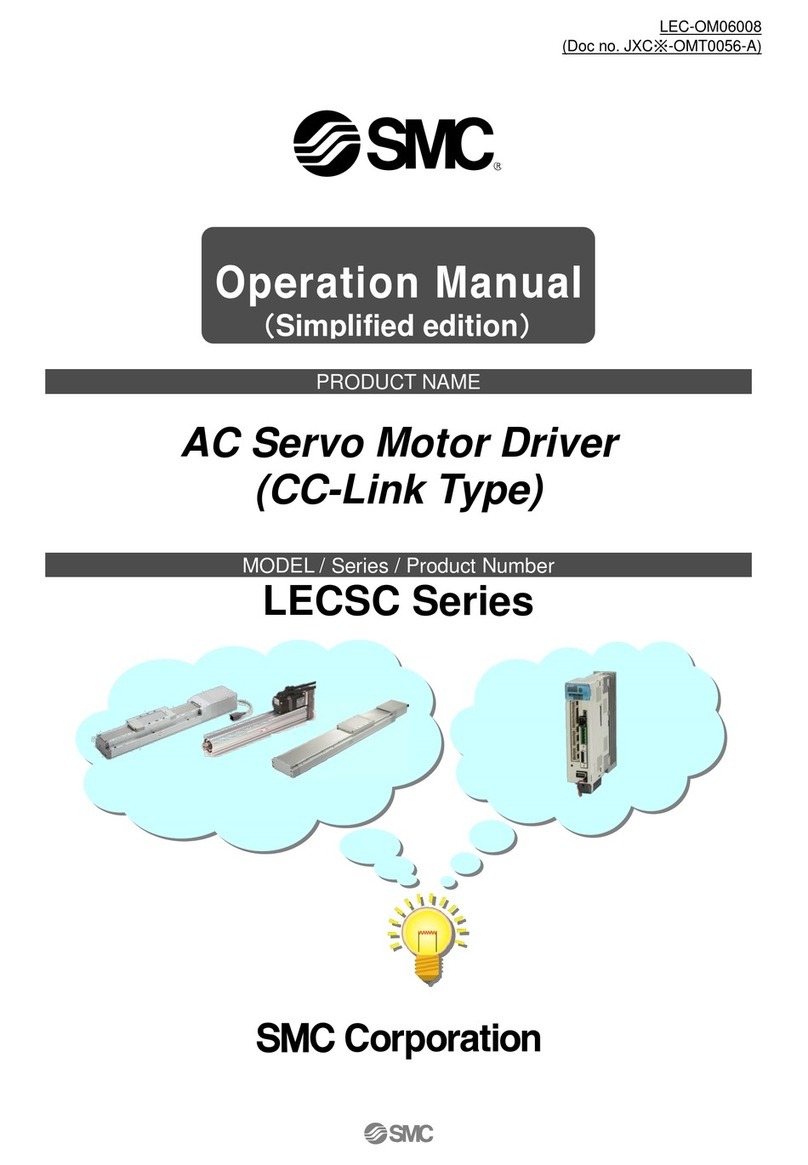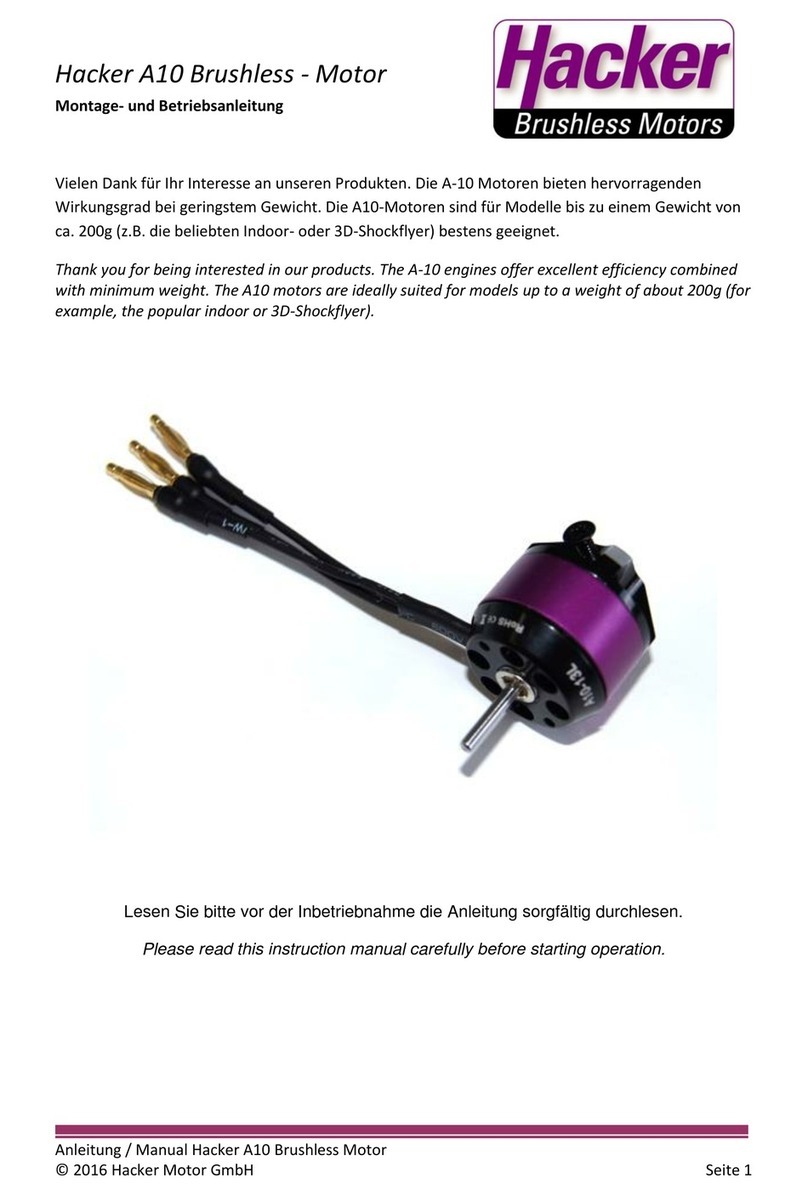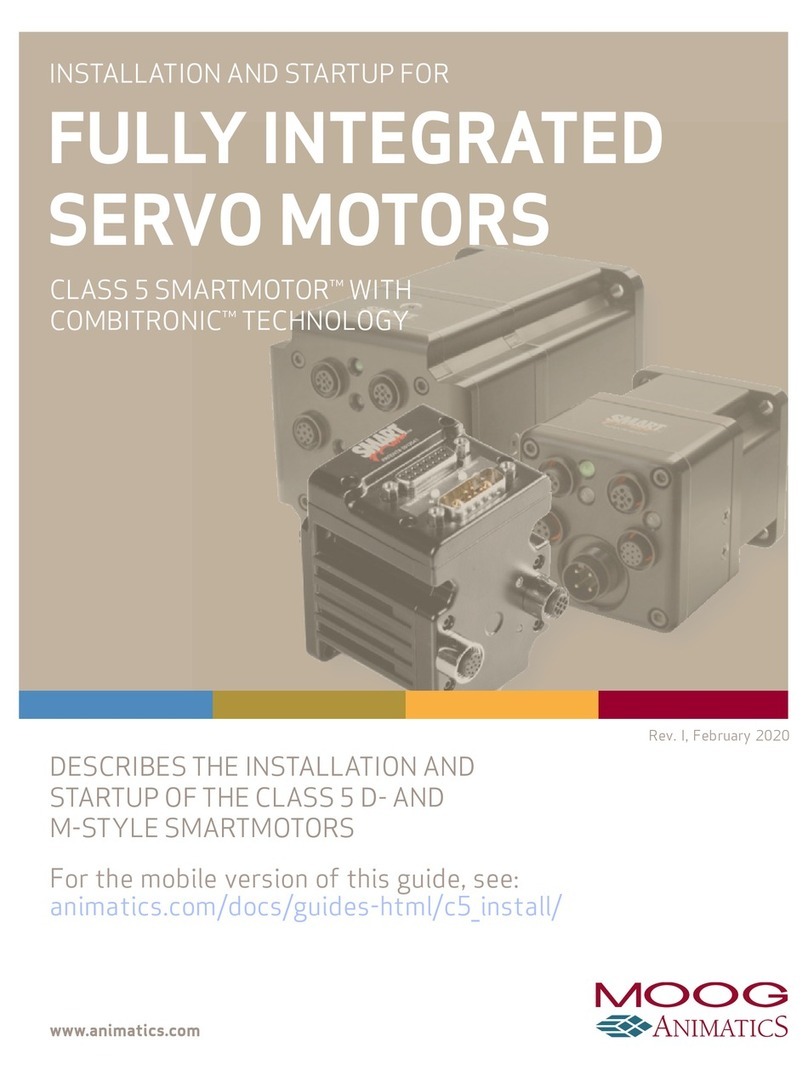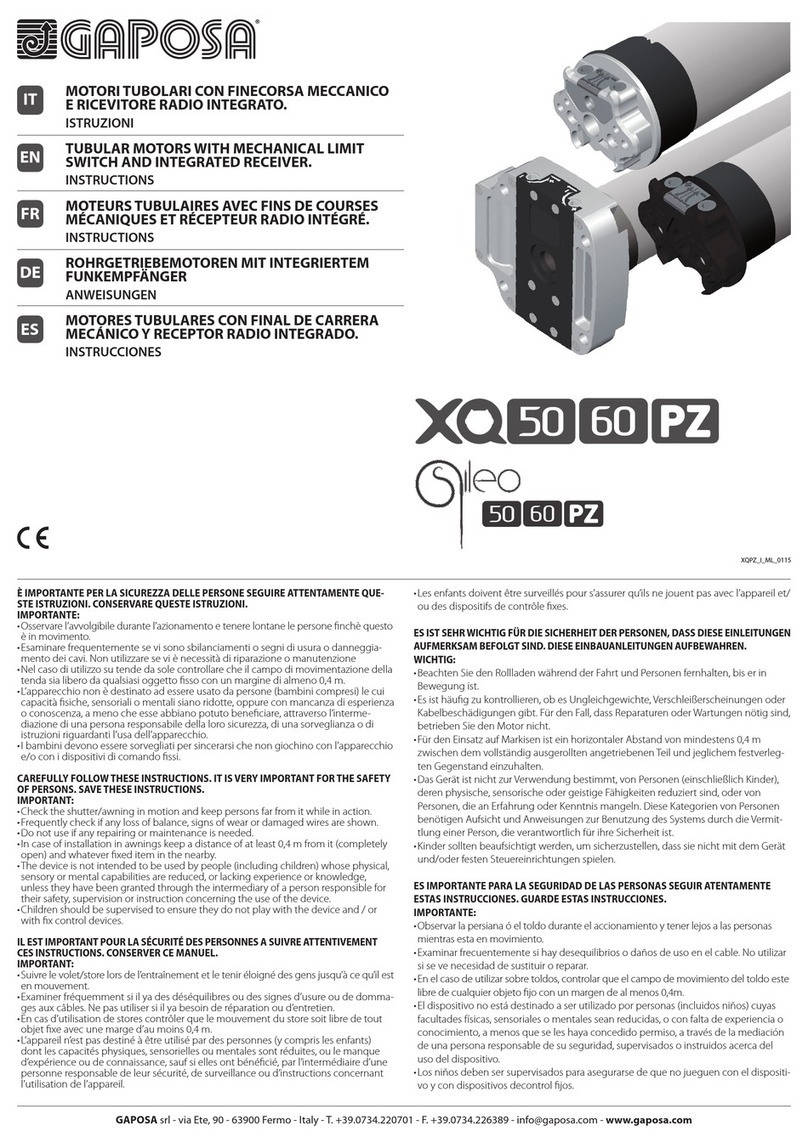Gaspar Xicoy X45 User manual

Xicoy X45 TurboJet Engine
User Manual
Version 1.1/2019

User Manual X45 Version 1.0/2019
Copyright © 2019 by Xicoy Electrònica S.L. All rights reserved Page 2
Index
Features: ................................................................................................................................................................. 3
Legal ........................................................................................................................................................................ 4
Disclaimer ............................................................................................................................................................... 4
Warranty ................................................................................................................................................................. 5
Safety Notes ........................................................................................................................................................... 6
Notes ...................................................................................................................................................................... 7
Engine Specifications .............................................................................................................................................. 8
Engine Description .................................................................................................................................................. 9
Installation Notes ................................................................................................................................................. 10
Component Description ....................................................................................................................................... 11
ECU Display ........................................................................................................................................................... 15
Engine Installation: Electrical connections ........................................................................................................... 16
ECU setup ............................................................................................................................................................. 17
Preparing the engine for running ......................................................................................................................... 19
Important notes for kerostart engines. PLEASE READ ......................................................................................... 19
During startup ....................................................................................................................................................... 20
First engine runs ................................................................................................................................................... 19
Starting the engine ............................................................................................................................................... 21
Engine shut down procedure ............................................................................................................................... 21
WHAT TO DO IN THE CASE OF AN EMERGENCY ................................................................................................... 22
Adjusting the engine maximum power ................................................................................................................ 22
Autorestart function ............................................................................................................................................. 22
Throttle curves ..................................................................................................................................................... 24
Acceleration and deceleration settings. ............................................................................................................... 25
Exhaust tubes ....................................................................................................................................................... 25
Use in gliders and in 3D planes............................................................................................................................. 26
List of ECU message codes ................................................................................................................................... 26
Diagnoses .............................................................................................................................................................. 27

User Manual X45 Version 1.0/2019
Copyright © 2019 by Xicoy Electrònica S.L. All rights reserved Page 3
Congratulations on your purchase of this new generation Xicoy “X45” gas turbine engine. We are confident you will be
pleased with your purchase and your new engine will give you excellent service and maximum enjoyment to your
hobby.
The “X45” engine is the result of a very extensive research and development programme by Gaspar Espiell & Xicoy
Electronica SL supported by the latest fluid dynamics and analysis software to bring you an engine of unparalled
performance and incredible response in an amazingly small package. New electronics design and digital
programming sets a new high bar standard for this new generation of small jet engines.
Features:
45N / 10lb of thrust in a tiny 60mm case
Low Idle thrust just 1.8N / 6.5oz
Low weight of 395g / 14oz
Valves installed on-engine
ECU mounted on engine
Internal kero burner and thermocouple for clean exterior
Compatible with diesel and kerosene
Incredible start to idle of just 25secs
Fast spool up to max rpm
Super-fast auto-restart with normal and glider modes
Automatic cooldown after run with receiver power turned off
Automatic power-off after cooldown
Brushless high speed starter
Intelligent brushless fuel pump
High speed digital control of all components
Neat slip-on FOD screen included
Choice of display options, on and off board and Bluetooth Android/iPhone
Telemetry options available for most modern transmitters
New options are being added from time to time,
Keep watching on: www.Xicoyturbines.com for details

User Manual X45 Version 1.0/2019
Copyright © 2019 by Xicoy Electrònica S.L. All rights reserved Page 4
If you sell or pass on this engine to a 2nd or subsequent owner please also pass on this User’s Manual or its link, so they
can enjoy a safe and fulfilling ownership too.
The Xicoy Electronica SL responsibility is limited exclusively to the repair of the engine and accessories which are
outlined in the conditions of warranty.
Before unpacking the engine, please read through these notes and agree to the conditions of warranty.
Customer satisfaction is important to Xicoy Electronica. Technical support is readily available through your local
dealer and via email:
Xicoy Electronica SL, Plaça Pere Llauger Nau 18, 08360, Canet de Mar, Barcelona, Spain
Web site: www.xicoy.com Email: [email protected]
See our new turbine webpage at: www.Xicoyturbines.com
Legal
The engine design and contents of this User Manual are copyright Xicoy Electronica SL, Canet de Mar, Barcelona,
Spain. All rights are reserved.
This User manual, pictures and data are the property of Xicoy Electronica SL and cannot be used or reproduced in any
way with written permission from Xicoy Electronica SL.
Disclaimer
This X45 engine is a very sophisticated piece of machinery. Great care should be taken at all times when using the
engine. It should only be operated by those with appropriate skills and knowledge to do so. The engine is not a toy.
Incorrect operation or misuse can cause damage to property and bodily harm to operators, spectators or animals.
Xicoy Electronica SL accepts no liability any damage which may occur.
Xicoy Electronica SL assumes no responsibility for any errors contained in this document and is not liable for any
damages resulting from such errors.
It is forbidden to use this engine outside radio control applications, especially those that power vehicles to carry
people.

User Manual X45 Version 1.0/2019
Copyright © 2019 by Xicoy Electrònica S.L. All rights reserved Page 5
Warranty
The warranty duration for this Xicoy X45 engine is two years from date of completed purchase, or 25 running
hours, whichever comes first.
Warranty is valid solely for the original 1st owner and is non-transferable upon resale.
Warranty includes all supplied parts and is limited to manufacturing defects only.
Shipment costs forth and back, including packing and relevant customs fees are not covered by the
warranty, and will be at owner’s expense.
Damage or defective operation covered under warranty terms will be repaired and tested at no cost to original owner
(other than shipping expenses). Repairs not covered under the terms of warranty will be carried out by Xicoy
Electronica SL or their appointed agent after agreement of costs.
Before returning the engine or ancillary equipment for service or repair, please contact first your local dealer or Xicoy
Electronica SL central office to agree action and costs.
Do not ship before contacting Xicoy Electronica first.. Shipping anything from outside the EU without appropriate
documentation will introduce delay and costs at customs borders.
Please do not disassemble this engine or accessories (pump etc.). You will breach your warranty agreement and will find
it an unfamiliar sophisticated and precision assembly which you may not be able to reassemble without considerable
difficulty and specialist equipment.
Simply slackening the compressor nut on the engine will lose the delicate balance condition of rotor without which the
engine may not run without sustaining damage to the rotating assembly.
This warranty is voided if any one or more of the following conditions applies. In such a case Xicoy Electronica SL will
accept no responsibility for any damage or other consequence caused by engine operation.
1. The product has been subject to any form of operation using incorrect fuel, oil or fuel/oil mix.
2. The product is, or appears to be, crash damaged, the fuel pump is blocked due to particle ingestion,
electronics or pump-drive are flooded with fuel or water ingress, connection leads are cut or show loss of insulation
and/or short circuit or reverse polarity on battery or engine cable connection.
3. Unauthorized maintenance and/or modifications have been made to any part of the product; including
unlocking of the ECU and changing any of the manufacturers settings, or any items supplied has or appears to have
been disassembled.
4. Parts show damage by ingestion of foreign object (wires or pipes, sand, grit and small abrasive particles,
water or fluids, dry powder from extinguisher, etc.).
5. The engine has or appears to have been operated incorrectly or not in accordance to this operators manual.
6. The product has been or appears to have been misused, neglected or inadequately maintained.
7. The engine or fuel pump has or appears to have suffered damage or blockages in the fuel system due to being
run with unfiltered or contaminated fuel.

User Manual X45 Version 1.0/2019
Copyright © 2019 by Xicoy Electrònica S.L. All rights reserved Page 6
8. The engine and/or accessories show damage by physical contact with a corrosive substance through
operation or storage.
9. The engine has been used in 3D planes.
Safety Notes
Please remember that though this engine is very small and bijou it is most definitely NOT a toy and has the potential
to hurt you or others around you if misused. The engine is a very high performance machine in miniature and must
always be treated with a high level of care and safety when in your operation. It is your responsibility as owner, to
ensure safe and considerate operation at all times and conforming to the word and sprit of this User Manual. By
running this engine you agree to assume full responsibility for its safe operation.
If you sell or transfer this engine, please pass this User Manual or web link to the new owner.
The following guidelines should be read carefully and followed:
Always keep a C02 or similar gaseous fire extinguisher of at least 2kg contents close to hand when starting
and operating the engine. Do not use a powder extinguisher unless of last resort as the powder will ruin the engine if
it used.
Protect eyes and ears during the starting procedure.
Be especially aware this engine is very fast to start, initiate only when ready.
Please note this engine is extremely fast to spool to maximum thrust, use the throttle control carefully,
especially with very small models.
Be aware of the extreme intake suction, use the available and supplied intake filter screen always.
Always run the engine in open air as engine exhaust contains gases which can cause asphyxiation and
nuisance smells.
The engine WILL be very hot while running, so please don´t touch it.
Keep clear anything affected by heat away from the engine, especially the exhaust area.
Don´t run the engine anywhere near a source of flammable gases, liquids or materials.
Don´t run the engine or fly the plane in wooded or crop or other high fire risk areas.
Keep spectators, children and animals clear of starting area (10mtrs (30ft) radius away).
Always handle turbine fuel and oil with care as they are flammable and can cause a reaction with sensitive
skin. Store them in clearly marked containers and always dispose appropriately. Use protective gloves when mixing
and decanting fuel and oils. Avoid all skin, eye, mouth or ingestion contact with the liquids and ensure any spillage is
wiped up immediately. Clean any affected area with warm soapy water. Wash hands and any effected part
immediately after any contact.
Continued excess of fuel priming or failure of the internal burner to initiate the combustion can result in
pooling of fuel inside the engine which could cause excess flaming in event of subsequent ignition. The only method

User Manual X45 Version 1.0/2019
Copyright © 2019 by Xicoy Electrònica S.L. All rights reserved Page 7
to clear the engine is to tip it forward and allow excess to escape through the front of the engine. Mop up with a rag.
Tipping it backwards will not work as the internal construction of the engine prevents any liquid draining out to the
rear.
Notes
This engine is a real gas turbine machine with very high rotational speeds and high temperature fast moving exhaust
gases. Despite the small intake the engine is able to swallow a huge amount of air, and anything else that air can carry
with it. So before running please carefully check the area surrounding the front and back end of the engine for any
loose materials like rags, sawdust, sand or grit, modelling materials, liquids, or anything else that can be picked up by
the airstream and sucked into the engine, or blown out at speed by the exhaust.
If you are new to turbines or returning after some years it is a good idea to set up the engine on a simple test stand so
you can get familiar with its operation before installing it into a model. Use a maximum thrust setting that is
appropriate for your model especially on 1st flights. The RUN menu shows this clearly, see “derating”. A power/weight
ratio of 1:1 sounds great but can accelerate a model dangerously quickly and can lead to control or structural failure
of the model. If you have recent jet engine experience you should be able to install the engine straight into your
model but take careful note of the quick response in start-up and throttling. Every engine is carefully test run at the
factory to ensure it performs properly, so you can take confidence to know it is fully operational at time of despatch.
Being an internal combustion engine the engine will consume oxygen during running so must never be run inside or
in a confined space. The engine consumes a volume of air about 93ltrs/3.3cu ft every SECOND (ie, a dustbin full) so
can quickly use up a lot of air in a limited space, so only run outside in open air. Never try to slow the engine by
placing any kind of restriction on the intake or the exhaust or on the model. The suction is more powerful than any
vacuum cleaner and can do severe damage to anything passing into the intake. It can also collapse an airframe where
insufficient area for the intake air is provided, or is restricted in some way. The small fod screen supplied is intended
to prevent small articles being drawn into the engine like blades of grass, small stones etc. It cannot prevent a rag or
similar being accidentally jammed against the front of the engine by the suction, so please take great care. Never test
the suction with fingers or hand, these engines bite hard.
The engine exhaust exit is very small but with such a large volume of gas passing through it at pressure it makes a
loud penetrating noise. At a distance this noise is most pleasing but in close proximity (within 5mtrs/16ft) the noise
level can be very hazardous to hearing so always ensure you and any nearby helpers have proper ear defenders and
are wearing them while test running the engine. Ensure you check carefully the area where you plan to run the engine
and have someone keep lookout for inquisitive bystanders who could approach to see the source of the noise, as you
will be concentrating on the engine. Agree a system of hand signals in advance so they know what you are planning to
do and can warn you of any issue during the run, ie shut down in a hurry or reduce to idle if someone (or an animal) is
approaching, walking by, etc.
The engine has its own internal starting system and does not require any assistance or priming to operate. So please
do not try to assist it to start quicker or easier by administering any flammable agents, sprays or similar, into the
engine in the belief it will start better. It won´t, but it could result in causing a dangerous flashback or fire to start
which could rapidly get out of control and putting yourself in danger or more surely the destruction of your model.
The engine does not need priming like a petrol or glow engine to start, so when filling the fuel line for the first time

User Manual X45 Version 1.0/2019
Copyright © 2019 by Xicoy Electrònica S.L. All rights reserved Page 8
leave a couple of cms of empty pipe where it connects to the engine to be sure you have not pushed a puddle of fuel
into the engine which can cause a flame on start-up.
The engine is happiest operating with the cable connector facing upwards and the fuel inlet below. But if it suits your
installation better the engine can function safely in any orientation which suits your installation, but you will find
starting is quickest and easiest with the recommended positioning. If you find the engine cable length is not sufficient
for your installation, please do not cut it and try to extend it, please get in touch with the Xicoy office for a longer
version.
The engine has a replaceable 6V internal starting burner. This is an Authorised Dealer and/or Service Agent
replaceable component as the engine must be opened to access it. Note - unauthorised opening of the engine will
void the warranty. The burner has been designed that the rotor is not disturbed during this process so the balance is
retained. The engine also features an internal thermocouple. This avoids the danger to this delicate component being
outside the engine from the usual knocks and bumps associated with engine install and refit. If the thermocouple
needs attention please refer to nearest Service Agent or direct to Xicoy Electronica SL as the engine case requires
opening to access it.
The engine starter is a high quality high speed brushless unit. The power driver for this is part of the ECU. It should go
without saying you cannot replace this with anything else. You also cannot power the starter separately beyond using
the “starter test” function. The starter is accessible and in the unlikely event of attention can be easily replaced. The
small clutch fitted to the starter motor has a small O-ring which may wear in service. It is easily replaced if required.
Please note that the accessories used for this engine use the simple 3-wire servo type cable connection. This includes
the fuel pump, display, sensors, telemetry adapters etc. In all cases the third wire (usually orange or white) is a digital
signal line so DC power should not be applied to this line or attempts made to read the voltage on this line for fault-
finding purposes.
Please refer to the Xicoy office for guidance in the first instance in event of any issue.
Engine Specifications
Engine diameter 60mm / 2.35”
Length 160mm / 6.3”
Engine weight 398g / 14oz
Total installed weight 760g/16.5oz
Nominal thrust at sea level 45N / 10lbs (continuously derateable to 20N / 4.5lbs)
Idle thrust 1.8N / 0.4lbs
Max rpm 225,000

User Manual X45 Version 1.0/2019
Copyright © 2019 by Xicoy Electrònica S.L. All rights reserved Page 9
Idle rpm 60,000
EGT at max thrust 550 -700´C
Fuel consumption at max thrust 140g / 4.7oz per min
Minimum exhaust tube diameter 45-50mm / 1.8-2”
Battery recommended 2S LiPo or 3S LiFe >1000mAh
Glow plug volts 6v
Restart capable, 2 modes, manual (glider) & automatic
Fuel / Oil, Kerosene or diesel + 4% oil mix. See text for breakdown
*The specifications may be subject change without notice as new updates and developments are added to the
production model.
Engine Description
The engine is a miniature turbojet design produced specifically to produce thrust to power small model aircraft. It has
a single stage billet machined centrifugal compressor and single stage cast Inconel axial flow turbine mounted on a
single shaft. The engine is fitted with a long life ceramic glow plug which enables the engine to initiate combustion
directly on liquid fuel after which further fuel is gradually introduced into the main part of the combustion chamber
to provide combustion heat to operate the engine. A high speed brushless electric starter motor fitted with a clutch
mechanism to the front provides drive to the rotor up to self-sustaining speed for starting the engine. The starting
sequence is controlled by an electronic system fitted to the engine (ECU) which initiates the start sequence and
controls the parameters of the engine within design limits.
The engine rotor shaft is supported by two ceramic bearings which are lubricated by a small percentage bleed off the
pressurized main fuel supply, which should contain a small percentage of oil for this purpose. The rotor discs are
separately balanced and then 2-stage dynamically balanced on assembly to the engine. Disturbing the rotor will lose
this delicate balance and the engine will need to be returned to a service unit for rebalancing.
The fuel for the engine is provided from a fuel tank and fed through a small pump driven by a 3-phase (brushless)
motor that has its own intelligent control. The engine speed between idle and maximum is controlled by varying the
speed of the fuel pump rotor by command from the electronic device called an ECU (Electronic Control Unit) that is
mounted under the front cover of the engine. This sends commands to the fuel pump via a connector board (Hub) to
turn at a certain rpm (and therefore flow rate) to deliver a precise amount of fuel and the fuel pump automatically
adjusts itself to this rate. The communication between the ECU and fuel pump and all other function accessories,
display, telemetry etc is via a single wire bidirectional digital data link, no analogue voltages are used and operation
is not voltage sensitive.

User Manual X45 Version 1.0/2019
Copyright © 2019 by Xicoy Electrònica S.L. All rights reserved Page 10
To control the admission of fuel to the burner and main combustion chamber there are two miniature electric valves
attached to a mounting block fitted to the front of the engine, under the cover. This block also holds the 4mm quick-
release fuel feed connection. The valves are connected to and controlled by the ECU as required by the starting
sequence. The valve block assembly is replaceable but the individual valve assemblies are not user serviceable.
The battery power for the engine can be within the range 7.4v to 9.9v, so 2S LiPo and 3S LiFe are suitable.
Installation Notes
1. The engine should be mounted securely using only the strap mount supplied.
2. The 3-wire connecting cable from the engine to the connector board should be carefully routed away from the
engine intake so there is no possibility of the wire being accidentally ingested if the FOD screen should be displaced
for any reason. Avoid placing the cable close to the engine rpm sensor which is located at approximately 4 O´clock
when viewed at the front of the engine with the cable entry plug at 12 O´clock. A cable too close can cause some rpm
interference at start-up. The same goes for any servo wires passing near.
3. The 4mm fuel feed pipe should be routed similarly clear of the intake.
4. The other end of the engine cable should plug into the Hub sited at a convenient location for access. This is
also the location to connect the ECU battery. If battery is sited at some distance perhaps in the nose of the aircraft,
please contact Xicoy and ask for a longer cable in one piece. Please don´t cut it and splice in a couple of old bits of
wire to make it longer. A heavy duty extension can be used but check polarity before plugging in. Its always better to
have a longer single piece cable for minimum volt drop and maximum reliability.
5. The centre of the fuel tank should be located as close to the centre of gravity (CofG) of the model as possible.
This will minimize the effects of the CofG shifting as the fuel is used during the flight. The fuel tank should have an
effective fuel pickup, like a felt clunk or felt bag over a weighted clunk to ensure no air is pulled into the fuel feed.
6. The fuel pump should be located close to the fuel tank as convenient. Fit the inline filter between tank and
pump to protect the pump from particles that could jam the pump. The pump has two 3mm screw fixing holes
provided for mounting to the airframe.
7. Run a single piece of tubing between the pump and the engine. Do not install anything (valves, filters,
flowmeters..) between the pump and the engine.
8. If using “Tygon” flexible piping from fuel tank push on a short (12mm/1/2”) length of the supplied 4mm pipe
onto the pump suction port and push the “Tygon” over the top to provide a tight leak free fitting. A double wrap of
lock-wire will ensure secure connection. Otherwise, use the 4mm piping supplied.
DO NOT use tie wraps anywhere on the fuel system.
9. DO NOT use “Tygon” flexible piping anywhere for the pressure (delivery) side, it is only suitable on the suction
side. Also DO NOT use silicon tube anywhere in the fuel system as the fuel will melt it.

User Manual X45 Version 1.0/2019
Copyright © 2019 by Xicoy Electrònica S.L. All rights reserved Page 11
10. Any air ducting to the engine inlet should have sufficient diameter of at least the engine case diameter (60mm
/ 2-1/2”).
11. If an extended exhaust duct (internal tailpipe) for internal installation is required, it should be 45 to 50mm
(1.8-2”) diameter and stiff enough to resist flattening in the airflow. Leave a gap of 25mm (1”) from tip of the exhaust
to the end of the duct (excluding bell mouth length).
12. Extreme care should be taken to avoid the possibility of foreign objects, loose parts or debris being allowed to
enter the compartment where the engine is installed. Always use the supplied FOD screen but regard this as a last line
of defence and not as a reason not to practice good housekeeping. Before filling the tank and starting the engine for
the first time, turn the model upside down and give it a good shake to loosen and clear any small bits and pieces lying
in the engine compartment. A go-around with the hoover is also a good idea.
13. We recommend testing the engine on a test stand prior to fitting to an airframe.
14. You should have a clear idea how to arrange all the components needed to run the engine inside the model.
The main issues are fuel tank (locate centre of tank to CofG), bubble trap position (if used), locating the fuel pump in
close proximity to the source of the fuel (bubble trap or tank) and adjusting the receiver and ECU batteries to achieve
optimum location for balancing the model.
15. Do not under any circumstances try to run the fuel pump by plugging it into any other FADEC brushless pump
control or similar type 3-phase driver. It does not work like that and you will destroy it in the process.
Component Description
ECU (Engine Control Unit)
The ECU and indeed the whole system used on this engine are totally new and unlike any previous version of Xicoy
ECU. It is a new controller developed specifically for this application by Xicoy Electronica which is in the form of a
small C-shaped pcb fitted under the front cover of the engine. It is connected via the 3-wire cable which plugs into the
engine and to a small connector board called the “Hub” externally. The three wires are just plus (+) minus (–) and
data. The signals in and out of the ECU are via bidirectional digital data link, no direct connection to the outside world
is required, or possible.
The ECU is a powerful new design using a completely new architecture than used before, so represents not an
upgraded version of anything before but a new system completely. This new platform allows us to break from the
limitations of older technologies to make use of the latest high speed connectivity to add many more functions than
were possible before, and all using a single wire data cable. All signals in and out of the ECU go via the Hub which acts
as a clearing house for ECU data and the outside world.
The ECU is programmed specifically for the X45 with the engine operating characteristics, start parameters, throttle
curves and operating routines. Some of these are user settable like the radio setup and maximum thrust settings
which are accessed used via a menu system on a special data display which plugs into the Hub. A version of the Hub
will be available with a display built in and with adjuster buttons which you can mount in your model, to eliminate

User Manual X45 Version 1.0/2019
Copyright © 2019 by Xicoy Electrònica S.L. All rights reserved Page 12
the need to plug in anything. The screen is very bright making it easy to observe the start-up on the display from a
short distance through a canopy, for instance.
Menu Items. Users familiar with other Xicoy ECUs will notice the menu structure is very similar to previous
generation ECUs, but with some display items in new positions, some extra functions added and some removed. This
is mainly because the ECU is specially produced for the X45 so functions which have previously been general purpose
are now tuned specifically for the engine and fixed. Anything which could be pre-set or does not require adjusting has
been removed from access to shorten the menus as much as possible to de-clutter.
Auto battery recognition
Kero / Diesel selector
Max thrust pre-set
Pump pre-set
We have added a few special options like the kero/diesel option which switches between pre-set routines for each
fuel. This saves you the ordeal of having to make many adjustments to fine tune the starting every time you switch
fuels, now you just press a button to click your fuel, and go. Diesel being heavier and higher flashpoint fuel than
kerosene requires a different start technique to enable it to start quickly and cleanly. We have spent time optimizing
the engine for each fuel and have prepared two start routines. You choose the fuel option and leave the ECU to use its
pre-set start routine.
To limit the engine to a reduced maximum rating there is a simple setting in the RUN menu which shows maximum
rpm with a corresponding nominal thrust figure. So it is easy to dial in say 35N (8lbs) without having to know the rpm
setting for this. This adjustment is operative between 20N (4.5lbs) and maximum.
Battery recognition. Another addition is automatic detection and accommodation for 7.4v LiPo and 9.9v 3-cell LiFe
batteries. The ECU detects the battery voltage at plug in, and automatically adjusts the starter maximum rpm to
make use of the additional voltage available. This is particularly useful in very low ambient pressures or areas of the
world with high altitude conditions where small engines have particular difficulties in starting due to the relatively
low rpm achieved on regular starters. In this case the 3-cell LiFe battery with the brushless starter can assist the X45
engine to start all the way up to idle rpm. Conversely, on plugging in the regular 2-cell LiPo battery the ECU will reset
the peak starter rpm to the usual speed.
The heart of the ECU is one of the latest high speed microprocessors which enable it to carry out millions of
instructions per second and do a great many things at the same time without having to stop and wait. It has its own
memory so can hold programme instructions and operating data and store runtime data from previous engine runs.
The ECU also controls the power to operate the two valves, the brushless starter motor and the glow plug. Two of the
three wires in the 3-cable are the power for these.

User Manual X45 Version 1.0/2019
Copyright © 2019 by Xicoy Electrònica S.L. All rights reserved Page 13
Connector board, the “Hub”. To enable connection of the power supply and signals to and from the outside
world to the ECU, a small connector board which we call the “Hub” is provided. This forms the connecting point for:
The receiver throttle signal (max voltage 10v)
ECU battery (volts 7.4 – 10V)
Fuel pump
ECU on the engine
Any display used, either on board as part of the connector board, or separately plugged in
Additional input sensors such as pitot pressure, rpm from a 2nd stage, etc
Additional output devices such as telemetry, SD memory storage, Bluetooth etc.
The Hub has some intelligence of its own in that it can take a signal from the ECU and isolate (power down) the ECU
battery after a cooldown has completed and the receiver turned off. The ECU will complete the cooldown process
even if the receiver is turned off, it does not need a radio signal to do this. This saves the battery in the transmitter
and receiver and helps stop the possibility of leaving them on for long periods accidentally.
The Hub will be available in several options, the simplest being the smallest option which is plain board to connect
ECU battery, receiver, ECU, fuel pump and a full colour external display. This is ideal for the smallest installation,
small foamies etc. Others will have a display or indicator lights included on the board, or with Bluetooth connectivity
included, or other options. The Xicoy website: www.xicoyturbines.com will show what is available for the X45 at any
time, new items are being added regularly.
The Hub has a printed panel showing where each cable goes and the orientation of each plug. For all cables, if you
need a longer or shorter version than supplied, please contact Xicoy. Do not cut or splice in extra wire.
Battery should be connected directly to the Hub, not using switches, electronic regulators, diodes etc. Multiple
battery operation using “Y” lead is possible but at least one battery must be directly connected.
If you are using the full colour, plug-in display this is also plugged in here.
Fuel Pump
As mentioned previously, the fuel pump has been specially designed for this application and is unique in many ways.
It is extremely small in size and weight but is much more sophisticated than its looks suggest. There is not the usual
fixed cable with socket but a small plug built into the pump which enables a regular high quality JR type servo cable
to be used as the pump cable (socket at both ends). This way it’s easy to get just the right length you need without
cutting or extending the wire.
Note: the three wires are NOT the 3-phases usually used for a brushless motor. The three wires are for the plus and minus
power supply, and a single wire bidirectional digital link.
Construction. Inside the sturdy machined aluminium housing is a powerful, purpose made brushless (3-phase)
motor with a ball raced (not plain bearing) shaft carrying a pair of precision close tolerance gears to provide the
displacement pump function. A pair of nipples provides a secure connection for 4mm piping at inlet and outlet. Two
tapped holes in the body provide a secure mounting location avoiding the need for tie-wraps and other messy fixings,

User Manual X45 Version 1.0/2019
Copyright © 2019 by Xicoy Electrònica S.L. All rights reserved Page 14
for a neat and tidy installation. Never try to disassemble the pump, it has an extremely delicate internal structure and
you will void its warranty.
Operation: The difference between this pump and most others is that it also has its own tiny brushless 3-phase driver
included within the pump housing. The motor is not a slave to an external driver or an open loop dc motor driven by
an external voltage, but has its own sophisticated controller and driver built in. This controller communicates with
the ECU via the Hub many hundreds of times a second. The ECU sends out an rpm request to the pump and receives
actual rpm information and therefore flow rate return signals back, and this process is updated continuously at high
speed.
Please note, you must not try to run the pump by plugging this 3-wire cable into any brushless (3-phase) driver, the
controller will be immediately destroyed.
This system means the ECU does not have to spend time constantly controlling the pump speed, it only needs to send
a brief signal to request a certain rpm. The on board controller then looks after how this command is carried out and
confirms it back when this is achieved. This enables the ECU to do other things like updating telemetry or collecting
data from sensors, while still controlling the engine operation.
Pre-setting: The pump initial flow rate is set at the factory with the engine, by simply setting the minimum rpm it
produces sufficient heating from the burner for a start. This is the only required adjustment. Once set, the user needs
make no adjustment to pump commands. Being based on a brushless motor it does not suffer from sticky seals or
variable speeds due to atmospherics or fuel densities unlike regular DC motor based pumps. So the old juggle with
adjustable “pump start point” is no more. To accommodate the idealising of the start process required for kero and
diesel fuels we have pre-programmed in an optimised sequence for each, activated by a simple switch in the START
menu. Select the fuel type you are using and the ECU does the rest.
Replacement pump pre-set. In event of the pump needing replacement for any reason the user can set the new
pump to the default setting (100 rpm) and see the heating effect on the engine on a start. If slow to heat up then the
value can be raised to the next level (125) and so on until a satisfactory setting is found. There are a limited range of
values, with jumps of 25 between each so the process is quick and straight forward. Once set, this value can be left
and does not usually need adjusting in normal use. All other start functions are handled automatically by the ECU.
Applying a DC voltage to the fuel pump will not make it run so please do not try it. Modifying the cable and reverse
connecting the polarity of the power supply wires will also not make it run but may destroy the internal pump
controller, so don´t risk ruining your pump by modifying your cable, just get the right length you need.
Mounting: The fuel pump mounts using the two M3 tapped holes in the body. Orientation is not critical but is ideally
mounted with the pipes uppermost to minimise the possibility of trapped air bubbles.
Connection: The pump direction of flow is marked with an engraved arrow from inlet to outlet. The fuel pump inlet
should have the fuel filter installed closely inline to prevent any particles getting to the pump and jamming it. Use the
4mm piping supplied. The ring on the metal filter denotes the outlet to go to the pump. Do not run the engine without
a filter.
Bubble-Traps: (like the Xicoy and BVM models “UAT”). A bubble-trap type hopper tank system is highly
recommended and available in the Xicoy Jet Shop. The bubble-trap outlet feeds direct to the inlet to the filter. If using

User Manual X45 Version 1.0/2019
Copyright © 2019 by Xicoy Electrònica S.L. All rights reserved Page 15
an air trap which has a fine bag type filter (Xicoy) then the external filter CAN be omitted but beware the pump is
vulnerable to particles getting in between bubble trap and pump inlet, so aim to be squeaky clean with the
installation.
The fuel outlet from the pump connects directly to the engine with 4mm piping. Do not put anything else in this fuel
line. If desired a 4mm shut-off tap can be installed inline in the suction side, between the pump and the tank as a
protection or where local regulations require.
Priming: It is strongly recommended that after a new installation or modification to the fuel system that the system
be primed: (Note the engine itself does not require any priming)
To prime the fuel system, disconnect the fuel pipe at the engine and route it into a suitable container. Run the fuel
pump for a few seconds using the Pump Prime function accessed via the INFO menu. Note the ECU battery must be
connected to do this. This will help clear any air and dust particles that could have entered the fuel system during
installation.
ECU Display
There are two display options with the X45 engine set, depending on which package you select. One is a separate
multicolour high resolution display mounted in a small case with a servo type lead coming out. This can be plugged
into the Hub as required or can be connected and mounted permanently in the plane. The other type is a very small
black and white small screen integrated onto the Hub. This is internally electrically connected to the connector board
so requires no additional lead, but cannot be removed from the plane. Both displays include dedicated screens for
engine operation, radio checking, last shutdown cause and other special turbine operations.
ECU data record / playback the most innovative and useful function is the internal recorder/playback function. The
multicolour high resolution display continuously stores all the data received from the ECU, keeping in its permanent
memory all the data of last 66 minutes of engine run, without the need of the memory card. After the flight the display
can be removed from the plane and be powered up with a receiver type battery and the data stored can be played
back in real time, same presentation as if the engine was running. Playback mode can be still, forward or reverse,
speed x1, x 10 and x100 in both directions, so that would be easy to view the engine operation or investigate any issue
at the field without the need of a computer or any other type of reader. All the data, including all engine parameters,
can be saved later to a memory card, where it can be read using a text editor, or our viewer software. Also this data
can be sent to Xicoy to be studied.
The function of the buttons is described later in the “ECU setup”

User Manual X45 Version 1.0/2019
Copyright © 2019 by Xicoy Electrònica S.L. All rights reserved Page 16
Display Screens
Initial Screen
Initial screen with Xicoy logo.
Button Tools, to visualize menu.
Button HDT, to visualize fadec data.
HDT Screen
Button Back x , to go initial screen.
Data from FADEC.
Buttons to navigate trought FADEC menus.
Tools Screen
ButtonBack x, to go initial screen.
Button Player to go Player.
Radio Check to go Radio Check.
Button Last Shutdown to go Last Shutdown.
Button File to go File.
Player Screen
ButtonBack x, to go initial screen.
Button Play Last Run to visualize last run.
Button Play From to visualize stored data.
Radio Screen
ButtonBack x, to go initial screen.
Radio Check Screen to visualize the set points:
Full Power, Stop & Idle.
Last Shutdown Screen
ButtonBack x, to go initial screen.
Last Shutdown screen to visualize the last
shutdown cause, RPM, Temperature and pump
on shutdown.
File Screen
ButtonBack x, to go initial screen.
Button Save Data to export the data to uSD.
Button Update to update the firmware of the
display.
Engine Installation: Electrical connections
The X45 is a very simple to install engine but main thing to be very careful of is any cable or battery connector which is
not standard or has been modified in some way, as this can risk reverse connection of power supply which will easily
destroy ECU and other components, so please be extra vigilant before using junkbox cables and/or adapters.
It´s always best to use those supplied in the engine package which have been used in setting the engine up for its
factory tests.
Please don´t give in to temptation. If you don´t have the recommended type battery, please obtain one of the
recommended types (2S LiPo or 3S LiFe, others are not supported). Do not risk ruining your engine by trying to get it
going by using a mains type power supply. Such a power supply needs to be very smooth (regulated) and capable of
very high peak current at the exact recommended output voltage and such units are rare. A battery charger or similar
will almost certainly be unregulated and have high voltage peaks which will destroy the components of the engine,
and such use invalidates your warranty.
Just order yourself a good, high quality battery of the recommended type and use the wait for it to arrive by checking
through your installation and these notes.
When it does arrive please double check the polarity of the connector supplied before plugging in.
A reverse polarity battery connection WILL destroy the ECU and engine components.

User Manual X45 Version 1.0/2019
Copyright © 2019 by Xicoy Electrònica S.L. All rights reserved Page 17
ECU setup
The ECU is contained on the engine. All the operating parameters relating to the starting and running of the engine
are contained in its memory. All communications with the outside world occurs through the cable connected to the
external Hub unit. The signal from the user radio receiver throttle channel is used to initiate and control all functions
relating to engine operation.
Interaction with the ECU and modifying or adjusting of any parameter or setting is done via buttons on a display unit,
also plugged into the Hub. The ECU battery should be plugged in as well as receiver, to access the display.
The ECU on the engine and all its components have been carefully programmed and tested together at the factory.
They are then subject to rigorously testing together to ensure they all operate as expected so there is very little for the
user to do to get the engine operational beyond the installation process and align the transmitter to the ECU
Once the engine is correctly installed and the components of the fuel system are fitted and connected up, the ECU
can be aligned to the radio system. This is a simple procedure which should be done whenever your radio is
programmed for a model, or the engine is new or returned from service or repair. Confirm you have connected the
ECU signal input to the throttle channel on your receiver. Connect the display to the Hub if your system uses a
separate display. Connect the ECU battery and note the display screen illuminates. To navigate through the menus
the two left buttons move up and down the menus, the two right buttons increase and decrease the value set. There
is no need to confirm any settings as changing a value automatically update it.
Remove all rates, mixes, and throttle travel settings in the transmitter. Before doing any adjustment on the ECU,
check that your transmitter is sending the correct signal by checking the reading on the display.
Press the 2nd button from left once to show an information screen. Note at the top left there is a number showing the
received radio signal shown as “Pulse = xxxxuS”. It should be between 900-1050uS at STOP position, between 1100
and 1300uS at IDLE position and between 1800 and 2200uS at Full Power position. Ignore the % reading to the top
right for the moment. Please note that these readings are measured directly from the signal received from your RC
system, so you should readjust your transmitter if the values read are outside that the ones suggested.

User Manual X45 Version 1.0/2019
Copyright © 2019 by Xicoy Electrònica S.L. All rights reserved Page 18
On some Futaba transmitters, it has been found that the throttle channel the sense of movement may require
reversing (servo reverse) and to repeat the transmitter alignment. The setting up assumes the use of a transmitter
(TX) with manual trims.
If you use a TX with digital trims, is essential to use the switch in the TX programmed for the function "Throttle
cut", or “engine cut” which normally has the effect of producing the “trim-down” function. Using a digital trim
cause unstable idle, and delay in shutting off the engine in emergency.
Check your radio manual for this before you start. Avoid using the digital trim if at all possible.
Aligning transmitter with ECU
As the display does not photograph well we have reproduced the display readings as a green box. Turn on the
transmitter and receiver. The opening screen should show as below. Follow the steps shown to set your radio:
The correct adjustment of the throttle adjustment on the ECU can be verified in the second screen of the display as
used before. The percentage of the throttle position should read 0% at the position of engine stop (trim and stick
down), 100% with stick/trim full up and between 10% and 30% at idle.
This now completes your radio setup and should only need doing again if the radio settings are changed.
Failsafe, Never fly with the failsafe set to “hold”. It is strongly recommended that you setup your radio system
with the correct failsafe settings. In some countries is mandatory that the engine stops in 2 seconds in the case of a
failure of the radio link.

User Manual X45 Version 1.0/2019
Copyright © 2019 by Xicoy Electrònica S.L. All rights reserved Page 19
To program correctly the failsafe on your radio:
1) Adjust the travel of the throttle channel from -100% (stop position) to +100% (full power)
2) Adjust the ECU to your radio as described above.
3) Adjust the failsafe position of the throttle channel in your radio to -125%.
If all is correctly adjusted, the ECU will stop the engine immediately when receive the “STOP” signal (-100%), but if the
signal received is Failsafe (-125%) the ECU will set Idle power during 2 seconds, and, if after these 2 seconds the
Failsafe condition persists, will shut down the engine.
Once you have the radio programmed, check it by setting the throttle to any position, then switching off the
transmitter; after two seconds the “failsafe” reading should be displayed.
There are many more parameters that can be modified in the ECU, but we have specifically programmed your ECU
with the optimum settings and allowed access only to those needed.
Further adjustment should not be required and can only be carried out by Xicoy Electronica SL or your authorized
dealer or service agent.
Preparing the engine for running
A suitable test stand should be made to hold the engine. A pair of sturdy timber rails securely fixed to a base board
will suffice. Use screws to hold together, don´t rely on a nailed assembly. The engine can be secured to the rails using
good quality woodscrews. Use at least 20mm/3/4” long to be sure the engine is properly secure.
A platform/table/workbench is required to clamp or fix the test stand onto. Make sure this can be easily transported
outside and weight enough to ensure it cannot be blown over by the thrust of the engine. Set up the fuel tank, fuel
pump, battery and display onto the baseboard, ideally secured. Nothing should be fixed downstream of the engine.
Select a clear area for running – keep clear of areas with loose leaves, sand or other debris that could be picked up or
drawn towards the intake. Ensure the fuel tank is position well clear of the exhaust area and secured. You and your
helper and any spectators should stand at the front of the engine, not to the side.
Important notes for kerostart engines: PLEASE READ
The kerostart system used on this engine is a reliable and well tested system that produces very smooth and trouble
free starts. However, extra care and attention must be paid when starting a kerostart engine.
The main difference between gas and kerosene is that in the case of a failed ignition, the gas dissipates quickly in the
air and won't stay inside the engine. Kerosene (or diesel) is liquid and if unburned, will pool inside the engine and stay
there forever. The engine can hold a big quantity of kerosene inside. This kerosene will be ignited on next successful
start-up and will be pushed to the exhaust as soon as the airflow inside the engine is sufficient, then it will be ignited
in the exhaust, causing a hot start (in extreme cases a big fireball) that surely will not hurt the engine, but can destroy
the model.

User Manual X45 Version 1.0/2019
Copyright © 2019 by Xicoy Electrònica S.L. All rights reserved Page 20
During startup
It is recommended on a new installation, to initiate a start and then abort the 1st start after about 5 seconds. This
ensures fuel has reached all part of the engine. The start can then be repeated and allowed to complete. During the
start-up listen to the engine sound to check for positive sound of ignition, check looking from the exhaust that the
kero is burning, or check for an increase in exhaust temperature in the display. A small plume of white smoke from
the exhaust means that the fuel is not burning. The fuel is pooling inside the engine. Abort immediately the start.
Double check that the engine is not flooded. An extra security measure is to place a manual valve between the pump
inlet and tank, to prevent that during the process of filling the tanks or during storage, some fuel can arrive to the
engine.
After a failed start, or whatever condition that could cause that fuel be collected inside the engine (ie accidental
priming), ALWAYS empty the engine of fuel by tilting the engine nose down. Fuel will exit through intake. Do not tilt
upwards; as due at the internal engine construction the fuel cannot exit out through the exhaust.
Another big difference between gas start and liquid start is that the kerosene can keep burning slowly for a long time
inside the engine. This situation can happen during an aborted start, the start-up sequence is aborted by the user or
automatically before the engine arrive to idle. This can cause that the kerosene inside the engine keep burning for
long time, and could destroy the engine or the model.
IF START-UP SEQUENCE IS NOT COMPLETED, CHECK FOR FLAME INSIDE THE ENGINE.
If there is flame, then set the trim to idle position. The starter will be energized while the temperature is over 100ºC,
cooling down the engine automatically. If temperature reading is low, you can get the starter running in manual
mode by setting full throttle for over 3 seconds to engage the starter and blow out the flame. USE SHORT BURSTS OF
STARTER. Using the starter for long time can overheat and destroy the starter motor. In the case that the start-up
procedure has been aborted due to starter failure or the engine has jammed, then it will be necessary to apply the
CO2 fire extinguisher. A white smoke plume from the engine is a good indication here; mean that there is no fire
inside.
First engine runs
Confirm your test stand is securely fixed to a bench or heavy table. Keep your ear defenders within easy reach
and a CO2 fire extinguisher handy. VERY IMPORTANT ON KEROSTART ENGINES. Do not use a powder extinguisher, it
will ruin the engine.
Fill the fuel tank. Do not forget to filter the fuel, and to mix the oil.
Confirm all batteries are freshly charged and connected up.
Check there is a temperature reading on the display.
Ensure the running area is clear of onlookers – especially the prohibited zone of a 10 metre radius 180° arc
from engine centre around the rear
Verify that the fuel tube is full of fuel and purged of all air, if not; carry out the fuel system prime sequence as
described here. BUT do not prime fuel into the engine.
Priming the fuel system: Fuel system needs purging of all air after initial installation. Take extra care when priming
the line, ensure fuel is primed only up 2cm before the engine; fuel inside engine will cause excessive flaming during
start sequence. Priming is achieved by a menu on the display Set the trim to low and go to “Info” menu and then
travel to “Pump test”. Click on “on” /”off” to start/stop the pump manually. Please observe fuel line to engine very
Table of contents
Other Gaspar Engine manuals
Popular Engine manuals by other brands

Viessmann
Viessmann 4568 Operation manual

Briggs & Stratton
Briggs & Stratton 290000 Vanguardv Gasoline Operator's manual
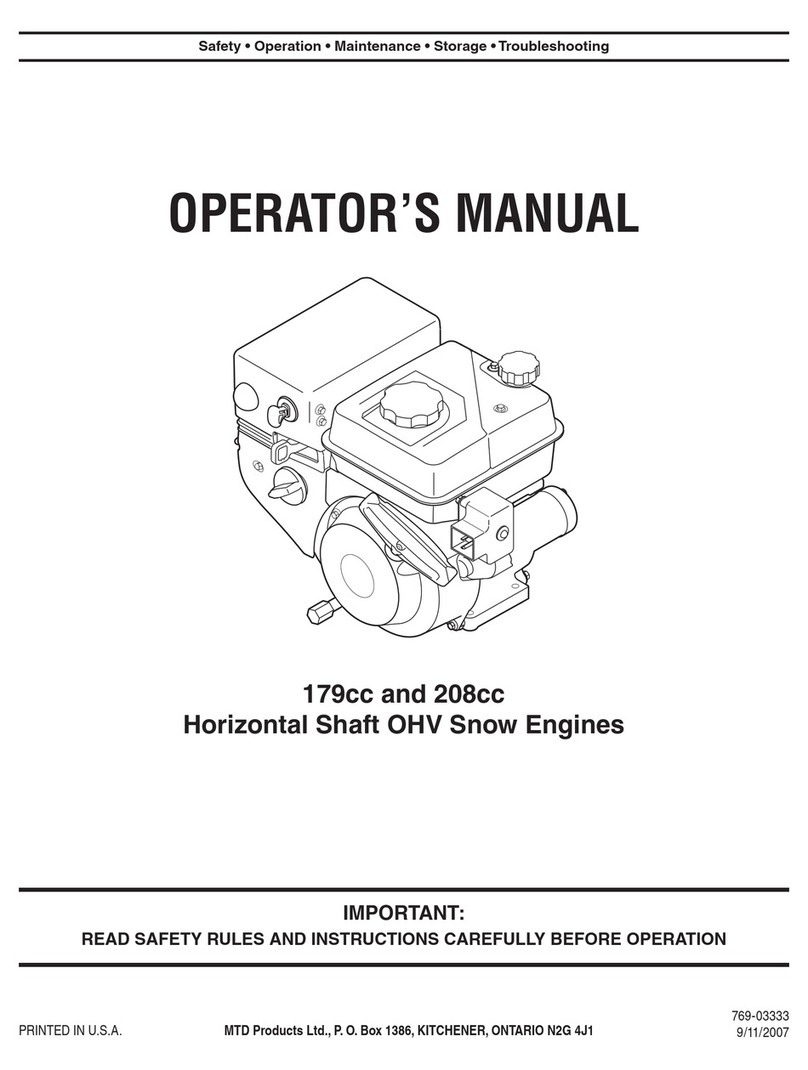
MTD
MTD 179cc Operator's manual
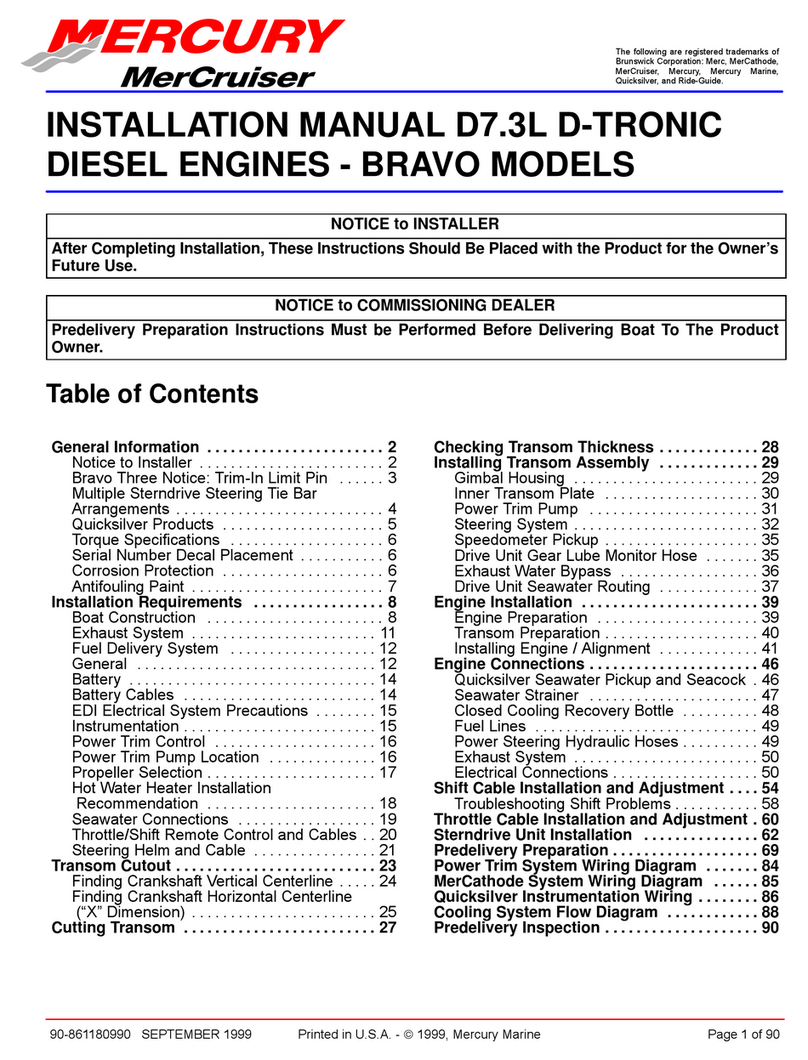
Mercury
Mercury MerCruiser D7.3L D-Tronic LD installation manual

MTU
MTU 20 V 4000 L63 operating instructions

Franklin Electric
Franklin Electric 214 Series Assembly and operating instructions
